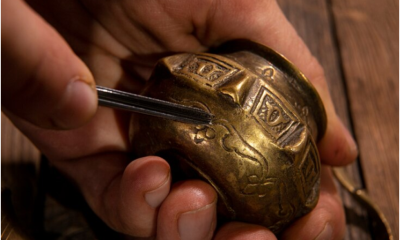Automotive
How to Replace Ignition Coil?

Ignition Coil
An ignition coil that doesn’t work properly can cause your car to perform poorly. Some of the symptoms that show the sign of failed ignition coil include an illuminated Check Engine Light (CEL), misfires, jerks, rough idle, lower fuel economy, and higher emissions.
If you left the problem unattended, the fuel that remains unburned inside a catalytic converter can damage the metal alloys inside by overheating. Similarly, this same raw fuel can also remove oil from rings and walls of cylinders, resulting in increased wear on your engine. So, when one starts experiencing any of these symptoms, then you should fix the problem as soon as possible.
To repair an ignition coil by yourself is a basic procedure that you can easily do at home with the tool by getting it from your nearest and most authentic local workshop. However, modern vehicles, especially those with sideways engines, can make testing and changing ignition coils more challenging. So, keep reading this article and get to know what you should do to make the job right.
You may also like to learn about; How to start a Car Battery?
Workings of a Coil Pack
Since the 1990s, vehicle manufacturers have replaced the mechanical distributor with an engine computer and an individually controlled coil-on-plug (COP) or coil pack instead, for managing timing and spark.
Next, the ignition coils provide the spark that fires all the spark plugs in an engine. Either it is directly connected to the spark plugs via spark plug cables, or each coil is mounted on top of the spark plugs, a style known as coil-on-plug (COP) or coil pack.
An automotive coil pack is typically a set of coils that are combined into one unit that provides the spark to each spark plug wire. Moreover, the coil-on-plug system is a coil that fits over each spark plug individually.
When the ignition coil fires, it is because of the crankshaft position sensor, which transmits data to the PCM, based on which plug should fire next and when, and then transmits a signal to the appropriate coil.
If you know exactly how it works, then probably you would get to see the need for an occasional ignition system maintenance, otherwise more parts of the car will start to break. In the case of a failing spark plug cable, the resistance will be much higher than normal. As a result of this higher resistance, your ignition coil’s secondary winding produces more voltage, which causes it to begin to break down prematurely.
Additionally, one more problem is water. Ford’s 4.6L and Triton V8 engines have a notorious coil failure problem caused by moisture. It could happen to any car engine, so if you want to replace the ignition coil, don’t forget to add dielectric grease to the boot.
How to Replace Ignition Coil
Before you start changing ignition coils always keep in mind that all the vehicles are different. We have provided general information only for entertainment and education purposes. So, make sure to follow all the repairing information carefully for your car.

Steps to Change Ignition Coils
Have you experienced intermittent spark and the “check engine” light on for a misfire or ignition coil? This blog can help you determine the issue and how to resolve this. If you are used to a single coil and distributor, multiple coil packs may seem intimidating, but they are as easy to replace as the traditional coil and distributor.
Step 1: Take Safety Precautions
At first, make sure your car engine is cool, then apply the emergency brake and open the hood. Always disconnect the negative battery cable before doing anything else.
Note: Before disconnecting the battery cable, check the car repair guide or manual.
Some of the cars of you would act negatively when the cable is disconnected for a longer time. It is possible to use a memory keeper/maintainer, but make sure there will be no damage to the electrical system or any other issues.
Step 2: Carefully Remove the Ignition Coils
Replacing ignition coils on some vehicles can be a bit challenging for you. You’ll find the most difficult part of this process is accessing and removing components such as the ignition coil insulator boots, which caught on the spark plug and ripped apart as you removed them. In some cases, it may be difficult to reach an ignition coil, and take removing the upper intake manifold to reach it. Now, there will be a need for a new plenum gasket in such cases. So, look at the repair guide for the specific application.
Once you have managed to detect and access the ignition coils, carefully disconnect the electrical plastic pigtail connector to avoid further damage. Sometimes, plastic connectors break due to age and deterioration. At this time, replacing the connector is much more difficult, so be ready always and use care. After that, remove the coil by unscrewing the bolts holding it in place.
When removing the spark plug insulator boot, a twisting motion is usually required. The stuck portion can only be removed from the spark plug with a pick and/or needle-nose pliers if it tears away. When you finish working on the spark plug, remember not to damage the porcelain on the spark plug, as this will cause a misfire and you will be right back where you began. If you have to replace more than one coil, make sure that you do each one at the same time.
You may need to identify each coil pigtail connector by stick-on numbers or by taking a picture before removing more than one. Inspect the boot of the coil and the spark plug well for contamination with oil or antifreeze after the coil is removed. If the leak is present, it should be repaired to prevent future damage and a repeated failure of the new system.
Step 3: Test Each Ignition Coil With a Multimeter
Normally, when your vehicle’s CEL flashed, there was a misfire code stored in the PCM. Use a code reader tool to read the code or visit your nearest automobile shop. There is a good chance that the code will identify the misfiring cylinder in most cases. Pay attention to the term ‘misfire’ not ‘failed coil’. This problem can arise because of many reasons.
Possible causes for miss-fire symptoms include parts of the ignition system, such as the spark plug, fuel injector, a vacuum leak, or even mechanical engine problems that result in low cylinder compression. The probability of an ignition coil failing is quite high, but if in doubt, there are options for testing.
If you can easily access the ignition coil, then try swapping the suspect coil with another coil on the engine. When the misfire passes through the suspect coil to the other cylinder, it means the coil has failed. If limited access does not allow this, you can test the primary and secondary windings of the coil using a multimeter. In case you strongly believe that you can’t do this, then refer to our guide or consult the local car workshop.
It’s important to replace the coil if the reading is outside the normal range. Check the owner’s manual to see what the normal range of resistance is. As soon as you have identified whether a coil has failed, you can install a new one. To ensure this happens properly, it’s wise to remove and inspect the spark plug first. Inspect it again for contamination, if there is any, and make sure all coolant and oil leaks are fixed. Also, check the spark plug well for debris and remove it.
Step 4: Lubricate The Coils and Install Them
In case, check that you have the correct coil. Connect the length and pigtail connection and also terminal pins. After that, apply dielectric grease to the inside of the replacement ignition coil insulator shield. This will help prevent moisture from seeping in and aid removal in the future.
Now, carefully install the coil and push it on the top of the spark plug. Then, reconnect the electrical pigtail carefully after re-installing the coil hold-down bolt. If dielectric grease is to be used, a very small amount should be applied to the coil or the connector. You need to ensure that the connector is snugly seated on the coil and that the connector tabs engage and hold the coil in place.
Step 5: Check The Process Done
Finally, re-install all the remaining components. Test the car by connecting the negative battery cable, starting the engine, and taking it for a spin.
Once you are sure that the problem has been resolved, clear the trouble codes. When your vehicle shows the signs of a bad ignition coil, it is time to do some DIY repairs. Be sure to get the tools you need at an auto shop and have any failing ignition coils tested and replaced before your vehicle breaks down.
-

 Education4 weeks ago
Education4 weeks agoCracking the Code: How to Ace Your Data Science Interviews
-

 Health4 weeks ago
Health4 weeks agoNurturing a Fulfilling Community and Lifestyle in Senior Living
-

 Business3 weeks ago
Business3 weeks agoVirtual vs. Physical: Selecting the Best Registered Business Address
-

 Business4 weeks ago
Business4 weeks agoContent is King: How to Create Digital Content Strategies that Engage Web?
-

 Health2 weeks ago
Health2 weeks agoTracing the Digital Path: A Chronicle of Concentrates and Hash in Canada’s Online Cannabis Market
-

 Automotive1 week ago
Automotive1 week agoAuto-Insurance Discounts: How to Save Money on Your Premiums
-

 Business3 days ago
Business3 days agoA Guide to Buying and Selling Estate Jewelry



